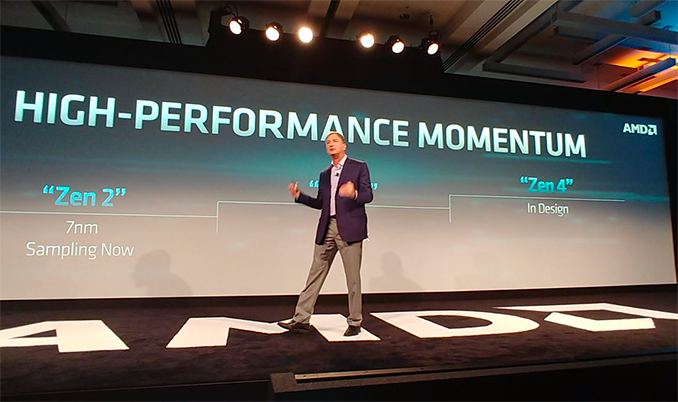AMD Announces Zen 4 Microarchitecture Under Development
by Anton Shilov on November 6, 2018 12:54 PM EST
At its Next Horizon event in San Francisco, AMD announced the fourth iteration of its Zen microarchitecture. The Zen 4 is currently in development, so the company does not share many details about it right now.
Right now, the company is sampling its codenamed Rome CPUs based on Zen 2 microarchitecture and made using TSMC’s first-generation 7 nm manufacturing technology (N7). After that, AMD plans to release a processor based on its Zen 3 architecture and these chips will be made using TSMC’s N7+ fabrication process that will take advantage of EUV lithography. Since Zen 4 microarchitecture is still in design phase, chances are that processors on its base will be made using a more advanced node, so think 5 nm, but keep in mind that any guesses today are speculations at best.
At its event AMD implied that the first CPUs based on its Zen 3 microarchitecture will ship in 2020, so it is natural to expect Zen 4 to reach actual products in 2021 or later. As for what to expect from the new microarchitecture, the company naturally promised higher performance and performance per watt when compared to prior generations.
Previously AMD has only discussed Zen 2 and Zen 3 microarchitectures, yet it is not surprising that the company will keep evolving its successful design in the coming years.
This is a breaking news. We are updating the news story with more details.
Related Reading:
- AMD's CEO Dr. Lisa Su to Host a CES 2019 Keynote: 7nm CPUs and GPUs
- AMD Updates its 25x20 Goal: Progress in a Generation
- AMD Ryzen 2nd Gen Details: Four CPUs, Pre-Order Today, Reviews on the 19th
- AMD Tech Day at CES: 2018 Roadmap Revealed, with Ryzen APUs, Zen+ on 12nm, Vega on 7nm
Source: AMD










16 Comments
View All Comments
Smell This - Wednesday, November 7, 2018 - link
Do Zen2 'chiplets' in EPYC Rome CPUs scale beyond 64 cores?Is this the practical limit of the (old Sea Micro) Infinity ('Freedom') Fabric?
psychobriggsy - Friday, November 9, 2018 - link
It would require a new IO chip with more IFOPs (Infinity Fabric On Package). A 12 IFOP IO chip could connect up 96 cores, in theory. You can see where they would go on the package.However the memory contention starts becoming an issue, it probably already is with 64 cores, despite the faster DDR4 support. So this may be something that waits for DDR5.
Also heat density on the package. 96 cores, but they would be slower than 64 cores to reduce power consumption and heat generation.
So, Zen 3, N7+, DDR5 - 96 cores seems viable.
Santoval - Tuesday, November 13, 2018 - link
You rather mean Zen 4, which should also support DDR5, have a new socket*, possibly move from 8 to 12 memory channels, etc Zen 3 will merely be an optimized Zen 2 (effectively Zen 2+), not a new design, just as Zen+ was for the original Zen. And if AMD adheres to the same pattern they will *not* release Zen 3 based Epyc CPUs, just as they did not release Zen+ ones.Zen 3 based CPUs should be the last generation with the same socket (AMD promised up to 2020) and only be released in mainstream and (possibly) Threadripper versions. These CPUs will certainly not have a different number of cores or any other significant new features, that will have to wait for Zen 4.
*It's unclear if you can add PCIe 4.0 support and retain the same socket. Perhaps it's not possible and AMD's promise of keeping the same socket up to 2020 was about their mainstream and perhaps HEDT CPUs, not their server ones, thus they are due to change the socket of Epyc in 2019. But that would mean no PCIe 4.0 support for both Zen 2 *and* Zen 3 mainstream and HEDT CPUs, with such support being added to Zen 4 in 2021. I highly doubt they would do that, so I wonder how they are going to handle this.
levizx - Saturday, November 10, 2018 - link
IF has nothing to do with Freedom Fabric. FF is more like inter board connection, IF is a direct descendant of HTCheapSushi - Wednesday, November 7, 2018 - link
Do you think DDR5 will come with Zen 3 or Zen 4?RogerAndOut - Thursday, November 8, 2018 - link
With the central IO die there should no longer be a need for the processor cores to have to be designed around a particular memory standard. If all AMD has to do to support DDR5 is release a new IO die we could see DDR5 support very quickly if AMD is happy to create another socket standard. This could add to Intel's headaches as they would have to redesign their main CPUs rather than just a support chip.